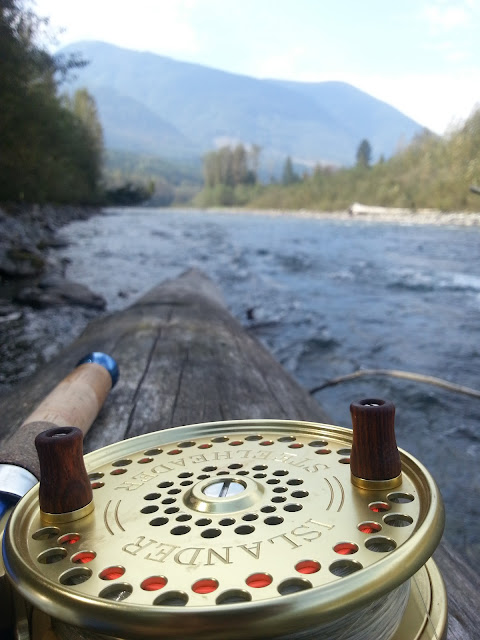Today's post is brought to you by the letter 'E' for 'ethics' and 'effective'.
After visiting the river last weekend and seeing so many people bottom bouncing for salmon that are very willing to bite, I thought I would post on how to properly short float for salmon. I am not going to get into the whole bottom bouncing/snagging debate except to say that I don't do it. I have decided to take an educational approach to prevent new anglers from being caught up in this method of fishing by carrying a 'float fishing kit' with me when I go to the river. This kit will be given to random bottom bouncers who may need a little education in a better way to target salmon. The following is a brief introduction to short floating for salmon. There are many wonderful videos and resources on the internet so if you want to get more detailed information, Google or YouTube are a great start.
Float fishing for salmin is a very effective way of fishing. You will find you will lose less gear and snag leess fish. Remember a snagged fish must be released, so for those of you that like to take their fish home float fishing is a better way to fish.
Float fishing in its simplest form involves a float, a few split shot weights, a swivel and a hook. One thing to note is I used a bright yellow braid for the purposes being able to see the line. I use a mono main line although some people do use braid. It is a matter of preference. I tend to use anywhere from 8 to 25 pound main line depending on what species I am targeting. Obviously a larger fish requires a larger pound test.

To begin with, slide your float onto your main line starting from the top. In these pictures I chose a simple foam float. These types of floats are quite popular. There are also two main kinds. There are straight through ones where the line passes directly through the middle from top to bottom. There are also the wrap around kinds as seen in my pictures. I prefer these over the straight through because the line comes out the side of the float before leaving through the bottom. This allows the float to be gripped by the line for easy set up and adjustment of fishing depth.
The tag end of the line will come out the side of the float. Next wrap it around the body of the float one or two times then through the side of the float near the bottom.
The tag end will now come out the bottom of the float. Pull some line through so you can add the swivel and the weight.
The next step is to attach the swivel and weight. I usually tie on the swivel first and then attach a couple split shot just above it. However some people like to use different weights such as pencil lead. It is a matter of preference. The main thing to remember is that the lead weight needs to be heavy enough to stand up the float but not so heavy that it sinks it under the surface.

The last part is tying a leader from the swivel to the hook. The leader should be a lighter pound test than the main line so in the event you snag up, the leader will break before the main line which prevents you from losing all your gear. The hooks I use for salmon are usually between a size 2 and a 1/0 hook. On the hook many people attach a small piece of wool in a bait loop or they fish roe. Other alternatives are drifting a colorado blade under the float or jigs I prefer to drift jigs. At this tine of year there are lots of chum salmon coming into our local waters and jigs can be deadly. They don't just work for chum though. Different colour variations work well for chinook, pinks, and coho too. The purple pink and chartreuse jigs pictured are my favorites for chum. The best part about fisuing jigs is they are weighted and stay in the zone and they ride hook side up. Having the hook facing up helps to reduce unwanted snagging of fish or debris. For chum I like to drift them just above the fish as chum can be quite aggressive and will move to a jig drifting above them.

When fishing a float cast to your favorite spot on the river and let the float drift upright down stream. It is important to get a natural drift. Do not hold back on the float and do not let too much slack out. Too much slack prevents a solid hook set. Watch your float and when it dips under the water, set the hook. It really can be just that simple.
Lastly, don't forget this has only been an introduction to float fishing for salmon. There are many other ways to fish this method but they all have commonalities. They all have a float, weight, a short leader and a hook of some sort. Now get out there and fish. Don't forget your licence and salmon stamp!




































